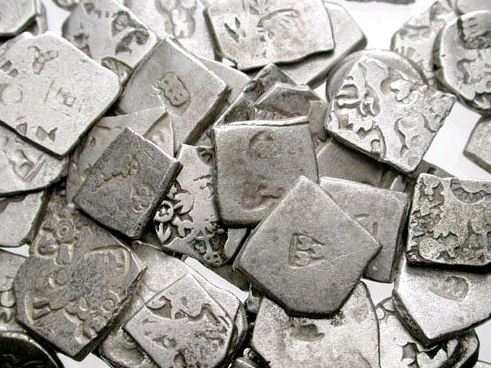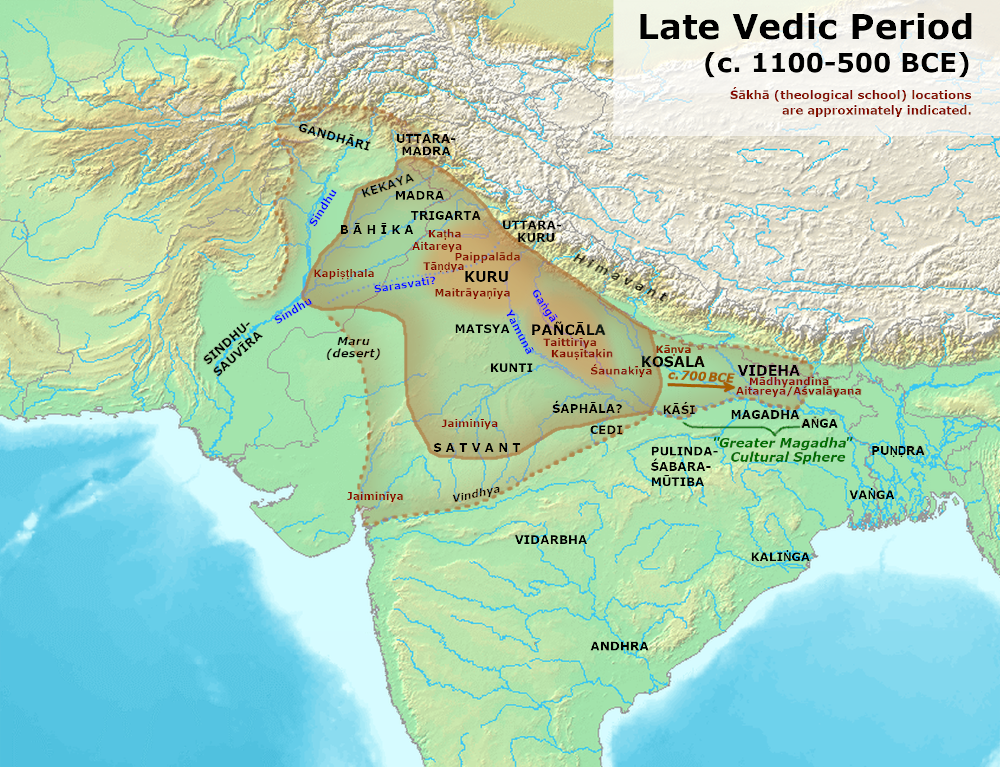The Post Vedic age is the era that is sometimes called Second Urbanization. The period of second urbanization (6th century B.C. to 3rd century B.C.) noticed the large-scale beginning of town life in the middle Gangetic basin. The widespread use of iron tools and weapons helped the formation large of territorial states. The towns became good markets and both artisans and merchants were organized into guilds under their respective headmen.
6th Century BC was the age of remarkable progress in different spheres of human life. The emergence of urban centers in North India was one of these developments for the 2nd time several towns & cities emerged in India because the 1st phase of urbanization was witnessed under the Harappan civilization.
The process of urbanization was the outcome of a solid material socio-cultural political base prepared by all-around progress during the 6th century BC. This process of urbanization continued for more than 1000 years & gradually engulfed the whole of India.
Economic Factors involved in Post Vedic Age
Role of Agriculture: The process of agricultural growth that started around 1000 BC had reached a state of agriculture surplus by the 6th century BC. By this time the peasants started using animal power in agriculture act more frequently pull the plowshare Agriculture expansion produced a huge amount of surplus which prepared a solid material base for the emergence of urban centers.
Role of Arts & Crafts: By the 6th century BC use of iron in arts & craft had increased further as a result of which several news crafts had emerged. Crafts based on leatherworking cotton & woolen textile, pottery, goldsmithing, coppersmithing & carpentry, etc. had also progressed immensely. The availability of agriculture increased the demand for arts & craft products. This process resulted in the emergence of craft centers such as Mathura & Urbanization that begin to be witnessed in North India.
Role of Trade & Commerce: Trade & Commerce witnessed the most remarkable 6th century BC. The availability of agriculture surplus & new craft products gave a boost to Trade & Commerce. Several other factors were responsible for remarkable progress in the field of Trade & Commerce such as the monetization of the economy, the emergence of the guild, knowledge of script & political unification witnessed in North India for the 1st time in Indian history coins were issued in 6th century BC. These coins are known as punched marked coins. These were small pieces of copper & silver having various symbols punched on them.

Monetization of the economy gave a boost to Trade & Commerce because it helps in the growth of exchange between North & West. The Vedic Aryan became aware of the script in the 6th century BC, the knowledge of the script facilitated the growth of Trade & Commerce because the account of the transaction could be maintained.
Guilds also emerged for 1st time in the 6th century BC. These were the organization of groups involved in the different economic activities such as arts & crafts & Trade & Commerce. Guild managed the market, check the quality of manufactured goods fixed prices of goods, looked after the welfare of its member & facilitated the transfer of vocational knowledge from generation to generation.
Guild also maintained troops to provide safety to its merchants. Guilds also enjoy judicial power over members. In reality, a guild was stated within the state. Their positive role helped in the all-around progress of the economy. The emergence of Mahajanpada resulted in political unification at a much bigger scale uniform admin implemented by rulers of these Mahajanpada supported trade & commercial acts.
King patron size merchant & traders for the overall benefit of state & people. Progress in the field of trade & commerce resulted in the emergence of several new Trade & Commercial centers on one hand & the other hand character of existing settlement got transformed.
Role of Social and cultural factor
The population increased over a period of time and contributed to the process of urbanization because the size of existing settlements increased and new settlements emerged over a period of time. The positive ideas & values put forward by heterodox sects of the 6th century BC created a solid ideological base for the emergence of the urban economy.
Leaders like Buddha, and Mahavira supported the practice of money lending. They were closely associated with reach merchants & traders. Materialistic outlook gained ground in North India as a result of remarkable progress witnessed in the economy. This outlook encouraged people to invest their time & resource in economic progress.
Previous Year Questions for UPSC Prelims
Ques 1: Consider the following statements regarding the source of Vedic Civilisation:
I. The most important source of Vedic Civilisation is the Vedas.
II. The Vedas are neither any individual religious work nor a collection of definite number of books compiled at a particular time.
III. It consists of three successive classes of literary creations.
Which of the following statement(s) is/are correct?
a. Only I
b. I and II
c. II and III
d. All of the above
Answer: Option D
Explanation: The Vedas represent the most significant source. Veda translates as “knowledge.” The Vedas are neither a single religious work nor a set of writings that were compiled at a specific time.
Vedic literature had developed over many centuries and was passed down orally from one generation to the next. There are three progressively more complex categories of literary works. Some of these still remain, but many of them are irretrievably lost.
Ques 2: Consider the following statements regarding the Rig Vedic geography:
I. The Nadisukta hymn of the Rigveda mentions 21 rivers which include the Ganga in the east and the Kubha (Kabul) in the west.
II. In the north, the Rigveda mentions the Himalayas and Mujavant mountains.
III. The Rigvedic geography, therefore, covers present-day western Uttar Pradesh, Haryana, Punjab, Rajasthan, Gujarat, the whole of Pakistan and south Afghanistan.
Which of the following statement(s) is/are correct?
a. Only I
b. I and II
c. II and III
d. All of the above
Answer: Option D
Explanation: We can clearly identify the geographic region where the Rigvedic people, who identified as Aryans, lived from the names of the rivers, mountains, and regions listed in the RigVeda. There are 21 rivers mentioned in the Rig Vedic Nadisukta hymn, including the Ganga in the east and the Kubha (Kabul) in the west.
Every river between the Ganga and Kabul rivers—including the Yamuna, Saraswati, Sutlej, Ravi, Jhelum, and Indus—is mentioned, not randomly but in order, starting with the Ganga and moving westward to the Kubha.
The Himalayas and Mujavant mountains are mentioned in the Rig Veda as being in the north. In relation to the Sindhu and Saraswati rivers flowing into the ocean, the word “ocean” (samudra) is also mentioned. In relation to international trade, the ocean is also addressed.
The entirety of Pakistan, south Afghanistan, and western Uttar Pradesh are all included in the Rigvedic geography, as well as Haryana, Punjab, Rajasthan, and Gujarat.
Quick Questions on Post Vedic Age for UPSC Preparation
What is Post-Vedic period?
The post-Vedic era is regarded as lasting from from 1000 BC to 600 BC. The Janapadas were created during this time period.
Is Vedic period important for UPSC?
Between 1500 BC and 600 BC was the Vedic Civilization’s historical span. After the Indus Valley Civilization, which lasted until 1400 BC, this is the next great civilization. Candidates for the UPSC IAS Prelims and Mains Exam can review additional NCERT Notes on Indian Ancient History.
What is Vedic Age?
It was between 1500 and 600 BC during the Vedic Age. Following the collapse of the Indus Valley Civilization around 1400 BC, this is the next significant civilization to flourish in ancient India. This age got its name since the Vedas were written during this time. The Vedas are the main source of knowledge regarding this time period.
What is the later Vedic Age?What is the later Vedic Age?
The later Vedic era began at 1000 BC and lasted until 500 BC. The Aryans started enlarging their lands at this time. Additionally, they overcame non-Aryans who started residing in their community. The king’s authority started to grow as the land area rose.
What are the two periods of Vedic Age?
In Indian history, the Vedic Age was crucial. The two periods of Vedic history are the Early Vedic Period (about 1500–1200 BCE) and the Later Vedic Period (around 1100–500 BCE).
Who are Rig-Vedic people?
The Rig Vedic Aryans were pastoral nomads who made their living mostly from raising cattle. Their animals were used to gauge their riches. They started farming when they made their permanent home in North India.
What is the difference between early Vedic period and later Vedic period?
Vedic period includes the Early Vedic Period and the Later Vedic Period. The early Vedic period, which began with the compilation of the Rig Veda around 1500 BCE, lasted for more than 2000 years. The Rigveda Samhita comes to an end. The later Vedic period lasted for around 1200 years (1500-500 BCE).

